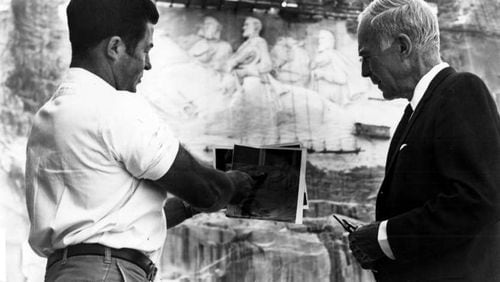From the archives: The story “Stone Mountain's mass appeal also brings some tall problems” was originally published in The Atlanta Journal-Constitution on June 16, 1985.
Stone Mountain Park's Memorial Lawn looked like the Civil War had resumed there by the end of last year, even though Jefferson Davis, Robert E. Lee and Stonewall Jackson hadn't budged an inch.
Each night during the summer, the Confederate president and generals stared stonily from their mounts on the mountainside carving as laser light panned the granite and an army of picnickers ravaged the lawn. By the time the siege ended, 2 million had seen the show and the grounds "looked like a battlefield, " says Larry Allen, the park's general manager.
This spring, the Memorial Lawn was sodded with $200,000 worth of zoysia in anticipation of even larger crowds expected for 147 showings of "Night on Stone Mountain."
The immense popularity of the park built around the world's largest granite monolith is a double-edged sword, park officials acknowledge. A healthy gate bankrolls improvements to existing attractions and allows for the construction of several new projects, but the four tons of litter picked up daily and hour-long traffic jams also take their toll on the natural setting.
Allen is projecting 6.4 million visitors to descend upon the 3,200- acre park this year, 500,000 more than 1984's record-setting attendance. The figures make high-flying Six Flags, which drew 2.2 million in 1984 and expects 2.4 million this year, seem like a parking-lot circus by comparison.
What gives Allen mountain-sized migraines is that the park's infrastructure wasn't designed for such abundance. A feasibility study undertaken in 1958, the year the state acquired the mountain, predicted the park would attract only 1 million by the year 1990.
The vast difference between that feasibility study and reality is what will pay for a planned $25 million conference center, among other projects. But it is also the impetus for talk about ending development in the park and preserving green space, said the general manager.
Allen, a fifth-generation Cobb countian who grew up on a farm in Mableton, predicts that in 25 years Stone Mountain will be as important to burgeoning metropolitan Atlanta as Central Park is now to New York City.
"It's the last big piece of greenery left, and I don't think it behooves us to have a 3,200-acre parking lot, " says Allen. "We're very, very sensitive to environmental issues."
Memories for Cleland
Secretary of State Max Cleland, who is a member of the Stone Mountain Memorial Association, the public corporation that operates the state-owned attraction, says the board shares Allen's concern.
"Our stockholders are the people of Georgia who entrusted this unique part of the world to us, and we're not going to screw it up, " says Cleland, 42, who has fond memories of hay rides and cookouts at the then- undeveloped mountain as a Lithonia teen.
But Roy Faulkner - who devoted eight years, five months and 19 days of his life to completing the Confederate memorial carving begun in 1920s - says the seven-member association "needs a talking to." The association's pursuit of new attractions like the conference center is at the expense of the park's history and natural beauty, says Faulkner.
In April, Faulkner, 53, opened the $2 million Stone Mountain Carving Museum, filled with an astouding array of memorabilia from his time on the mountainside. The 32,000-square-foot building, with its plantation- house facade facing Memorial Drive, is a stone's throw from the mountain's west entrance, but Faulkner said visits to the park "kind of break my heart."
"People used to look at it as a place to go on the weekends, spread your picnic lunch and enjoy the sights, " Faulkner says. "It's kind of gotten away from that."
He blames the laser show, which is projected on the carving, for turning the park over to a younger crowd intent on cruising around in cars, "getting hopped up" and "raising cain."
Standing amid his collection - which includes everything from the thermo-jet torch he used to flake the granite away to the elevator workmen rode 400 feet to the scaffolding - Faulkner says, "The (carving) is a monument, a memorial, and they're making a playhouse out of it now."
That opinion is not shared by Jim Mackay, a Decatur attorney and a former Georgia legislator who was secretary of a general assembly committee in the 1950s that encouraged the state's acquisition of the mountain.
Park management praised
"The 3,200 acres of Stone Mountain Park are a classic illustration of the difficulty of reconciling the conservation of a great natural asset with tremendous human use, " says Mackay, a member of the Georgia Conservancy's urban parks committee. "It has superb, sensitive management. Those of us who worked for the acquisition are extremely proud of the park today."
Allen, a longtime Six Flags administrator who took over at Stone Mountain 1 1/2 years ago, says his biggest challenge is playing to parkgoers' diverse interests - history, recreation and nature - while keeping the operation in the black.
The latter is particularly important since the park last year began repaying $328,500, or half of its bonded indebtedness, for three construction bonds issued in the early 1960s by the state. After splitting the payment with the Department of Natural Resources again this year, the park will begin making full payments in 1986, continuing until the remaining $3 million debt is retired in 1992.
The park expects to net $2 million this year, which will be poured into a number of projects.
Allen anticipates that construction will start on the 250-room, 74,000-square-foot conference center this year. Overlooking a peninsula on the park's east side, the conference center is intended to complement the Stone Mountain Inn, which recently underwent a $900,000 renovation. The inn remains at capacity all summer, while the convention center should attract new visitors in the spring and fall, Allen says.
1830s home will open
The park's historic offerings will be enhanced late this year with the opening of the rambling, white-columned home of Confederate hero Thomas Cobb. The circa 1830s Cobb House will be moved from Athens and reconstructed across the street from the Antebellum Plantation, a complex of 19 restored structures.
In May, the park opened the second, five-acre phase of Wildlife Trails, a natural-habitat menagerie conceived by "Wild Kingdom's" Jim Fowler. The park has already spent $1.6 million on the attraction, which Allen predicts will ultimately triple in size.
Another project in the works is a regularly running steam train excursion from the Georgia Railroad Depot at Underground Atlanta to the park. Allen says the 45-minute trip could become "one of the most viable tourist attractions in the city."
The state has already run the 1910 engine restored by the Atlanta chapter of the National Railroad Historical Society to Stone Mountain Village for special events. More than 900 feet of right of way would have to be acquired for the train to connect with the park's track, which circles the mountain, Allen said.
Park officials also contemplate adding another 18 holes of golf to ease the demand on the Robert Trent Jones-designed course, which Golf Digest ranked among the 25 best municipal courses in the country last year, Allen says.
In all, more than $2 million will be spent this year for everything from improvements to the Inn and the 525-space campground to new water slides and picnic tables.
To grapple with the crowds that all the additions and improvements will encourage, the park and the state Department of Transportation commissioned a comprehensive traffic study. The three-phase study will provide some "immediate Band Aids" as well as suggestions for road changes both inside and outside the park gates, Allen says.
Driving around the park in his pickup truck, Allen talks of the 24,000 dogwoods and 19,000 azaleas that were planted last year and his plan to add 50,000 of each annually in coming years.
That brings back a conversation he had with former Governor Marvin Griffin, shortly before Griffin died in 1982. It was during Griffin's administration that the state acquired Stone Mountain.
"He was telling me that some regarded it as 'Griffin's Boondoggle, ' his spending money to buy a big rock, " says Allen. "I told him I wish he'd bought 6,400 acres instead of 3,200."






